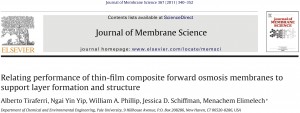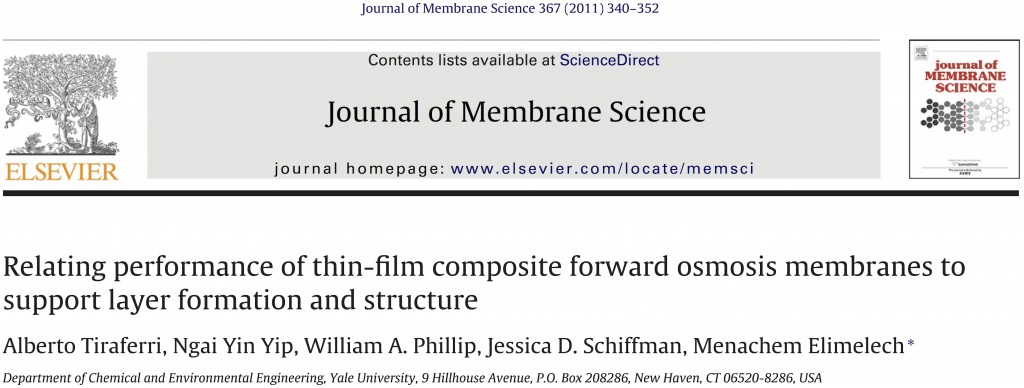- Nano-selective forward osmosis technology by SideStroem featured in Everything About Water - February 10, 2024
- SideStroem and Singapore Institute of Technology featured in AsianScientist - April 29, 2023
- SideStroem joins world class accelerator program - November 12, 2022
Why Tiraferri et. al. 2011 is a must read within the field of forward osmosis membrane development.
 In their article “Relating performance of thin-film composite forward osmosis membranes to support layer formation and structure” from 2011, Tiraferri and co-workers perform a systematic study on how the structure of forward osmosis support membranes affect overall forward osmosis performance. Since publishing in 2011, the article has been cited 112 times according to Google Scholar, which confirms its role as one of the most influential articles within the field of FO substrate development.
In their article “Relating performance of thin-film composite forward osmosis membranes to support layer formation and structure” from 2011, Tiraferri and co-workers perform a systematic study on how the structure of forward osmosis support membranes affect overall forward osmosis performance. Since publishing in 2011, the article has been cited 112 times according to Google Scholar, which confirms its role as one of the most influential articles within the field of FO substrate development.
The study is based on polysulfone support membranes prepared by phase inversion and subsequent interfacial polymerization for the active layer formation. The researchers vary the following support membrane casting conditions to achieve support membranes with different structural parameters (S values):
- Solvent used to prepare the polysulfone membrane precursor solution (also known as the dope solution)
- Concentration of polysulfone in the dope solution
- Wetting of the polyester (PET) backing material
- Thickness of the polysulfone solution film prior to phase inversion
Based on their work, Tiraferri et. al. conclude that support membranes with low structural parameters reduce internal concentration polarization (ICP) effects during FO operation and hence increase overall FO membrane performance. Scanning electron microscope (SEM) images of different support membranes reveal that the lowest structural parameters are achieved when the support membrane structure is characterized by “fingerlike” macrovoid morphologies stretching the entire thickness of the support membrane.
Interestingly, the researchers observe that forward osmosis membranes based on support membranes with “spongelike” morphologies (i.e. larger structural parameters) often outperform their “fingerlike” counterparts despite internal concentration polarization effects being more pronounced in the former. Tiraferri et. al. conclude that the active layer separation properties are superior (i.e. larger A and smaller B values) when the active layer is formed on an underlying “spongelike” structure.
Hence, when designing the optimal forward osmosis membrane support, the following end-goals should be prioritized:
- Maintaining a “fingerlike” membrane morphology in the bulk part of the FO membrane substrate to achieve low values of the structural parameter leading to reduced ICP effects during FO membrane operation.
- Achieving a “spongelike” morphology in the top layer of the support membrane, which forms the interphase towards the active layer, to ensure superior separation properties of the active layer once it is formed by interfacial polymerization.

